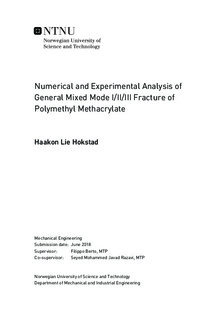Numerical and Experimental Analysis of General Mixed Mode I/II/III Fracture of Polymethyl Methacrylate
Master thesis
Permanent lenke
http://hdl.handle.net/11250/2562112Utgivelsesdato
2018Metadata
Vis full innførselSamlinger
Sammendrag
Mixed mode loading often has a significant effect on fracture behaviour in components.Cracks is in many cases the reason for failure or fracture of a component. Allof the mechanisms of cracks and fracture behaviour are still not completely known.This also applies for the three dimensional loading case of mixed mode I/II/III.This thesis will therefore study the existing theory on two dimensional, and threedimensional mixed mode loading. Mixed mode I/II/III brittle fracture behaviour ofpolymethyl methacrylate, PMMA, will be studied experimentally and theoretically,using pre-cracked CTS specimens. This specimens contains pre-cracks and will besubjected to different mixed mode loading conditions, ranging from pure mode I topure mode II and pure mode III. During this thesis, a mixed mode I/II/III loadingdevice were designed and used for the experimental procedure. Experiments wereconducted on all twenty five combinations of the loading device. The presentedmixed mode loading device allowed mixed mode I/II/III loading combinations insteps of 22:5, for in and out of plane rotations. After the conducted experiments,fracture loads were obtained. In-plane crack initiation angles and out of plane crackinitiation angles were measured for all of the fractured specimens. These experimentallyobtained results were then compared with predictions of various fracturecriteria. Maximum tangential stress criterion, MTS, generalized maximum tangentialstress criterion, GMTS, and the criterion by Richard were used for numericalpredictions in this thesis. Numerical analysis were conducted by obtaining resultsfrom three-dimensional finite element simulations in Abaqus, and applying them indifferent fracture criteria. The criteria showed a good relation with experimentallyobtained angles.
